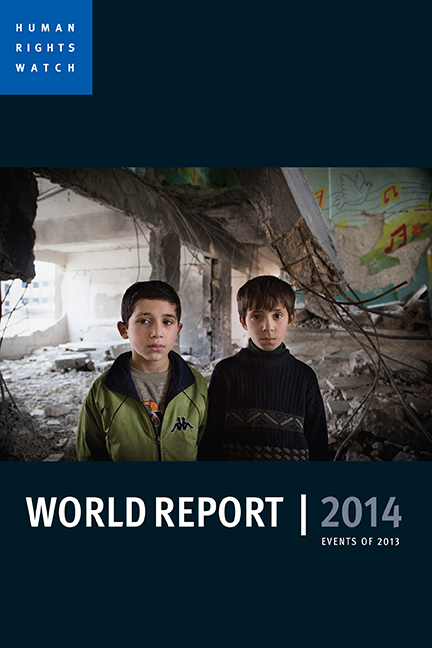Book contents
- Frontmatter
- Dedication
- HUMAN RIGHTS WATCH
- Table of Contents
- Foreword
- Rights Struggles of 2013: Stopping Mass Atrocities, Majority Bullying, and Abusive Counterterrorism
- The Human Rights Case for Drug Reform How Drug Criminalization Destroys Lives, Feeds Abuses, and Subverts the Rule of Law
- Putting Development to Rights: Integrating Rights into a Post-2015 Agenda
- The Right Whose Time Has Come (Again) Privacy in the Age of Surveillance
- Photo Essays
- AFRICA
- AMERICAS
- ASIA
- EUROPE AND CENTRAL ASIA
- MIDDLE EAST AND NORTH AFRICA
- UNITED STATES AND CANADA
- 2013 HUMAN RIGHTS WATCH PUBLICATIONS
- Acknowledgments
Central African Republic
Published online by Cambridge University Press: 07 May 2022
- Frontmatter
- Dedication
- HUMAN RIGHTS WATCH
- Table of Contents
- Foreword
- Rights Struggles of 2013: Stopping Mass Atrocities, Majority Bullying, and Abusive Counterterrorism
- The Human Rights Case for Drug Reform How Drug Criminalization Destroys Lives, Feeds Abuses, and Subverts the Rule of Law
- Putting Development to Rights: Integrating Rights into a Post-2015 Agenda
- The Right Whose Time Has Come (Again) Privacy in the Age of Surveillance
- Photo Essays
- AFRICA
- AMERICAS
- ASIA
- EUROPE AND CENTRAL ASIA
- MIDDLE EAST AND NORTH AFRICA
- UNITED STATES AND CANADA
- 2013 HUMAN RIGHTS WATCH PUBLICATIONS
- Acknowledgments
Summary
A rebel coalition known as the Seleka took control of Bangui, the capital of the Central African Republic (CAR), on March 24, 2013, forcing out the former president, François Bozizé. A transitional government was established, and Michel Djotodia was formally named interim president in April. New elections were scheduled for early 2015.
Rebels belonging to the Seleka, which means “alliance” in Sango, the national language, engaged in widespread human rights abuses, particularly killing civilians indiscriminately. These killings, both in Bangui and outside the capital, were often followed by widespread looting and pillaging, leaving sections of an already-poor population homeless and destitute.
Djotodia denied that Seleka fighters committed abuses, initially blaming the violence on Bozizé loyalists, “false Seleka,” or bandits. On September 13, he dissolved the Seleka as a group. However, members of the Seleka continue to kill with impunity and the central government does not appear to be in total control of the Seleka.
Armed groups originally created by Bozize to fight banditry, the anti-balaka (“anti-machete”), clashed with the Seleka in late 2013. Violence and insecurity took on an alarming sectarian dimension, as the anti-balaka, who are predominantly Christian and include some soldiers who served under Bozizé in the Central African Armed Forces (FACA), attacked Muslim civilians around Bossangoa, the capital of Ouham province, in response to Seleka abuses, mostly against Christian civilians.
The dire security situation hampered the delivery of humanitarian aid and Seleka fighters intimidated and harassed journalists and civil society activists.
An African Union (AU)-led peacekeeping force, the International Support Mission in Central Africa (AFISM-CAR) has requested financial, logistical, and technical support from the international community, but as of October 31 had only 2,589 of the 3,500 personnel requested.
Seleka Abuses
The Seleka was created in late 2012 out of three main rebel factions, primarily from CAR's impoverished north. The group called for more political inclusiveness and an end to the marginalization of the predominantly Muslim northern region. The Seleka includes fighters from Chad and Sudan, and it has recruited child soldiers.
The group launched an offensive in December 2012 and swiftly moved toward the capital, capturing towns along the way. A peace agreement was reached with the government in January, but was soon ignored by both parties, as the rebels advanced on Bangui, forcing former President Bozizé to flee.
- Type
- Chapter
- Information
- World Report 2014Events of 2013, pp. 90 - 95Publisher: Bristol University PressPrint publication year: 2014

